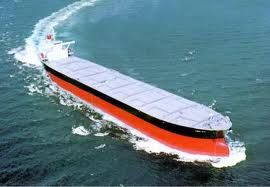
The dry freight market faces a growing ship glut, which has battered freight rates in recent months. Owners went on a ship ordering spree before the economic turmoil in 2008
and it normally takes three years for a ship to hit the water from when it is ordered.
Growing fears for the world economy signal more pain and even bankruptcies among dry bulk ship owners who are getting rock-bottom rates to carry cargoes like coal and now face a glut of new vessels ordered when times were good.
The tougher climate has hit the sector hard this year and confidence is at a record low. Korea Line (005880.KS), South Korea's debt-stricken second largest dry bulk shipping line, is among the casualties. The firm, under court receivership, has filed a restructuring plan to the court.
While cheaper rates could benefit buyers of commodities, the weak economic prospects are set to hit more ship owners.
"Smaller companies tend to have less access to capital, especially in weak markets. High financial leverage and weak earnings could force covenant breaches or defaults in the sector," Deutsche Bank analyst Justin Yagerman said.
The Baltic Exchange's main sea freight index .BADI or BDI, which track rates to ship raw materials, has already declined nearly 30 percent since the start of the year as ship supply has outpaced demand to transport strategic commodities including coal, iron ore and grains.
"A recession or recession like situation will actually prolong the period with poor freight markets," said Sverre Svenning, a director with broker Fearnley Consultants.
"In normal circumstances, governments -- especially in Europe -- would try and stimulate the economy through infrastructure and construction work but there is no government in Europe that has money for that now and the U.S. government definitely does not have money."
Investors worry that fiscal cutbacks due to Western credit softness and stagnating output are holding back global recovery. Weak U.S. services sector data and poor manufacturing data this week have compounded the fragile outlook.
Former U.S. Treasury Secretary Lawrence Summers wrote in a Reuters column this week that there is a one in three chance of a U.S. recession.
"If there were to be a double dip recession in both the USA and Europe, then it would feel like the mother of all recessions for the dry bulk market," said Khalid Hashim, managing director of the Thai-listed group Precious Shipping PSL.BK.
"It would probably take us to the bad old days of the mid 1980s when the BDI was barely above its all-time low of 557 points."
Hashim said that in such tougher economic conditions, he would not be surprised to see the BDI fall below the 1,000 point level and remain depressed for four to six quarters.
The index was seen by investors in 2008 as an indicator of the global contagion from the financial crisis, highlighting the fall-off in demand for raw materials.
During the boom times, the index posted a record high in May 2008 of 11,793 points. The financial crisis drove it as low as 663 points in December 2008. It reached 1,268 points on Thursday, having hit its lowest in more than three months early this week.
"A further a slowdown from here would be very bad news for the freight market," said Georgi Slavov, head of dry research and structured products at broker ICAP Shipping. "I really hope this is a short lived seasonal slowdown in the West."
The dry freight market faces a growing ship glut, which has battered freight rates in recent months.
Owners went on a ship ordering spree before the economic turmoil in 2008 and it normally takes three years for a ship to hit the water from when it is ordered.
Fearnleys said net fleet growth was forecast to reach 13 to 14 percent this year, despite a pick up in scrapping, versus more than 16 percent in 2010 and nearly 10 percent in 2009.
"There is an acceleration of deliveries since the early part of this year. We will have a market driven by the supply side with far too many ships," Fearnleys' Svenning said.
"The reduction of transportation that has taken place through slow steaming I believe has been used already," he said, referring to a method where ships slow down their speed to cut fuel consumption.
LONG PATH TO RECOVERY
Bank of America Merrill Lynch said this week it saw few prospects for a "sharp and unforeseen upswing" in demand.
"Given the softening in the global economy and a weaker outlook for iron ore demand in 2H11, we believe the dry bulk freight market will remain depressed near term," it said.
"Looking into the next years, we now believe that a real recovery in dry freight is unlikely before 2013/14 when vessel growth finally really lets up, giving demand a real chance to catch up with supply," it added in a report.
Analysts said a slowdown in western demand could also be compounded by softer raw materials interest from China, which has been a lifeline for the dry freight market in recent years.
Earnings for capsize vessels, typically hauling 150,000 tonne cargoes such as iron ore and coal, have fallen to record lows this year. Rates for smaller panamaxes have been volatile.
"I am less concerned about a double-dip recession but if you look at the latest steel production forecasts out of China, 2H (the second half) is forecast to be flat with 1H," said Janet Lewis, shipping analyst at Macquarie Securities.
"I'm not so sure that capesize rates get much worse but probably not much better. I think panamax rates will be the next to falter given the strong supply coming on the market."
Source: Reuters
We use cookies to improve your experience. By continuing to use our site, you accept our Cookies, Privacy Policy,Terms and Conditions. Close X